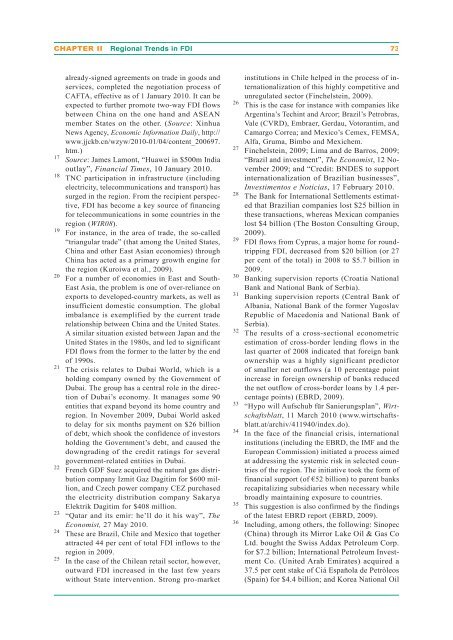UN World Investment Report 2010 - Office of Trade Negotiations
UN World Investment Report 2010 - Office of Trade Negotiations
UN World Investment Report 2010 - Office of Trade Negotiations
Create successful ePaper yourself
Turn your PDF publications into a flip-book with our unique Google optimized e-Paper software.
CHAPTER II Regional Trends in FDI 73<br />
already-signed agreements on trade in goods and<br />
services, completed the negotiation process <strong>of</strong><br />
CAFTA, effective as <strong>of</strong> 1 January <strong>2010</strong>. It can be<br />
expected to further promote two-way FDI flows<br />
between China on the one hand and ASEAN<br />
member States on the other. (Source: Xinhua<br />
News Agency, Economic Information Daily, http://<br />
www.jjckb.cn/wzyw/<strong>2010</strong>-01/04/content_200697.<br />
htm.)<br />
17 Source: James Lamont, “Huawei in $500m India<br />
outlay”, Financial Times, 10 January <strong>2010</strong>.<br />
18 TNC participation in infrastructure (including<br />
electricity, telecommunications and transport) has<br />
surged in the region. From the recipient perspective,<br />
FDI has become a key source <strong>of</strong> financing<br />
for telecommunications in some countries in the<br />
region (WIR08).<br />
19 For instance, in the area <strong>of</strong> trade, the so-called<br />
“triangular trade” (that among the United States,<br />
China and other East Asian economies) through<br />
China has acted as a primary growth engine for<br />
the region (Kuroiwa et al., 2009).<br />
20 For a number <strong>of</strong> economies in East and South-<br />
East Asia, the problem is one <strong>of</strong> over-reliance on<br />
exports to developed-country markets, as well as<br />
insufficient domestic consumption. The global<br />
imbalance is exemplified by the current trade<br />
relationship between China and the United States.<br />
A similar situation existed between Japan and the<br />
United States in the 1980s, and led to significant<br />
FDI flows from the former to the latter by the end<br />
<strong>of</strong> 1990s.<br />
21 The crisis relates to Dubai <strong>World</strong>, which is a<br />
holding company owned by the Government <strong>of</strong><br />
Dubai. The group has a central role in the direction<br />
<strong>of</strong> Dubai’s economy. It manages some 90<br />
entities that expand beyond its home country and<br />
region. In November 2009, Dubai <strong>World</strong> asked<br />
to delay for six months payment on $26 billion<br />
<strong>of</strong> debt, which shook the confidence <strong>of</strong> investors<br />
holding the Government’s debt, and caused the<br />
downgrading <strong>of</strong> the credit ratings for several<br />
government-related entities in Dubai.<br />
22 French GDF Suez acquired the natural gas distribution<br />
company Izmit Gaz Dagitim for $600 million,<br />
and Czech power company CEZ purchased<br />
the electricity distribution company Sakarya<br />
Elektrik Dagitim for $408 million.<br />
23 “Qatar and its emir: he’ll do it his way”, The<br />
Economist, 27 May <strong>2010</strong>.<br />
24 These are Brazil, Chile and Mexico that together<br />
attracted 44 per cent <strong>of</strong> total FDI inflows to the<br />
region in 2009.<br />
25 In the case <strong>of</strong> the Chilean retail sector, however,<br />
outward FDI increased in the last few years<br />
without State intervention. Strong pro-market<br />
institutions in Chile helped in the process <strong>of</strong> internationalization<br />
<strong>of</strong> this highly competitive and<br />
unregulated sector (Finchelstein, 2009).<br />
26 This is the case for instance with companies like<br />
Argentina’s Techint and Arcor; Brazil’s Petrobras,<br />
Vale (CVRD), Embraer, Gerdau, Votorantim, and<br />
Camargo Correa; and Mexico’s Cemex, FEMSA,<br />
Alfa, Gruma, Bimbo and Mexichem.<br />
27 Finchelstein, 2009; Lima and de Barros, 2009;<br />
“Brazil and investment”, The Economist, 12 November<br />
2009; and “Credit: BNDES to support<br />
internationalization <strong>of</strong> Brazilian businesses”,<br />
Investimentos e Noticias, 17 February <strong>2010</strong>.<br />
28 The Bank for International Settlements estimated<br />
that Brazilian companies lost $25 billion in<br />
these transactions, whereas Mexican companies<br />
lost $4 billion (The Boston Consulting Group,<br />
2009).<br />
29 FDI flows from Cyprus, a major home for roundtripping<br />
FDI, decreased from $20 billion (or 27<br />
per cent <strong>of</strong> the total) in 2008 to $5.7 billion in<br />
2009.<br />
30 Banking supervision reports (Croatia National<br />
Bank and National Bank <strong>of</strong> Serbia).<br />
31 Banking supervision reports (Central Bank <strong>of</strong><br />
Albania, National Bank <strong>of</strong> the former Yugoslav<br />
Republic <strong>of</strong> Macedonia and National Bank <strong>of</strong><br />
Serbia).<br />
32 The results <strong>of</strong> a cross-sectional econometric<br />
estimation <strong>of</strong> cross-border lending flows in the<br />
last quarter <strong>of</strong> 2008 indicated that foreign bank<br />
ownership was a highly significant predictor<br />
<strong>of</strong> smaller net outflows (a 10 percentage point<br />
increase in foreign ownership <strong>of</strong> banks reduced<br />
the net outflow <strong>of</strong> cross-border loans by 1.4 percentage<br />
points) (EBRD, 2009).<br />
33 “Hypo will Aufschub für Sanierungsplan”, Wirtschaftsblatt,<br />
11 March <strong>2010</strong> (www.wirtschaftsblatt.at/archiv/411940/index.do).<br />
34 In the face <strong>of</strong> the financial crisis, international<br />
institutions (including the EBRD, the IMF and the<br />
European Commission) initiated a process aimed<br />
at addressing the systemic risk in selected countries<br />
<strong>of</strong> the region. The initiative took the form <strong>of</strong><br />
financial support (<strong>of</strong> €52 billion) to parent banks<br />
recapitalizing subsidiaries when necessary while<br />
broadly maintaining exposure to countries.<br />
35 This suggestion is also confirmed by the findings<br />
<strong>of</strong> the latest EBRD report (EBRD, 2009).<br />
36 Including, among others, the following: Sinopec<br />
(China) through its Mirror Lake Oil & Gas Co<br />
Ltd. bought the Swiss Addax Petroleum Corp.<br />
for $7.2 billion; International Petroleum <strong>Investment</strong><br />
Co. (United Arab Emirates) acquired a<br />
37.5 per cent stake <strong>of</strong> Ciá Española de Petròleos<br />
(Spain) for $4.4 billion; and Korea National Oil

















